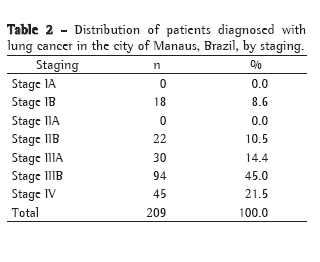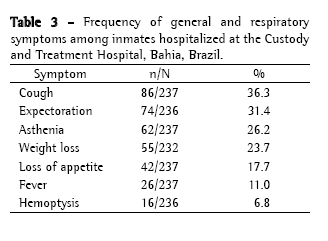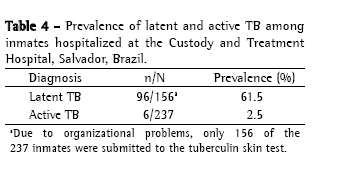

Juliana Franceschini, Alecssandra Aparecida dos Santos, Inás El Mouallem, Sergio Jamnik, César Uehara, Ana Luisa Godoy Fernandes, Ilka Lopes Santoro
ABSTRACT
Objective: To assess the quality of life of patients with lung cancer and to compare it with that of individuals without cancer. Methods: The Medical Outcomes Study 36-item Short-Form Health Survey (SF-36) was administered to 57 patients diagnosed with lung cancer, treated at the Lung Cancer Outpatient Clinic of the Hospital São Paulo, and to a control group of 57 individuals recruited from the Extra Penha workout group. The Mann-Whitney test was used to compare the groups, domain by domain. The first model of logistic regression was adjusted for male gender, nonsurgical treatment, Karnofsky performance status and smoking, which were included as predictors. The second model was adjusted for each SF-36 domain in order to identify increases in the proportions of patients in stage IIIB or IV. Results: The lung cancer group and the control group presented the following mean scores, respectively, for the SF-36 domains: role limitations due to physical health problems, 29.39 ± 36.94 and 82.89 ± 28.80; role limitations due to emotional problems, 42.78 ± 44.78 and 86.55 ± 28.77; physical function, 56.49 ± 28.39 and 89.00 ± 13.80; vitality, 61.61 ± 23.82 and 79.12 ± 17.68; bodily pain, 62.72 ± 28.72 and 81.54 ± 19.07; general health, 62.51 ± 25.57 and 84.47 ± 13.47; emotional well-being, 68.28 ± 23.46 and 82.63 ± 17.44; and social functioning, 72.87 ± 29.20 and 91.67 ± 17.44. The logistic regression model showed that role limitations due to physical health problems, physical function and emotional well-being were predictors of stages IIIB and IV. Conclusions: The patients with lung cancer had a poorer quality of life, especially regarding physical aspects, than did the control subjects.
Keywords: Lung neoplasms; Quality of life; Health status.
RESUMO
Objetivo: Avaliar a qualidade de vida de pacientes com câncer de pulmão e compará-la com a qualidade de vida de indivíduos sem câncer. Métodos: O questionário Medical Outcomes Study 36-item Short-Form Health Survey (SF-36) foi aplicado em 57 pacientes com diagnóstico de câncer de pulmão provenientes do Ambulatório de Oncopneumologia do Hospital São Paulo e em um grupo controle de 57 indivíduos participantes do Grupo de Ginástica Extra Penha. O teste de Mann-Whitney foi utilizado para comparar cada domínio entre os grupos. O primeiro modelo de regressão logística foi ajustado para sexo masculino, tratamento não cirúrgico, índice de Karnofsky e tabagismo, que foram incluídos como preditores. O segundo modelo foi ajustado para cada domínio do SF-36 para identificar aumento na proporção de estádios IIIB e IV. Resultados: O grupo com câncer de pulmão e o grupo controle apresentaram, respectivamente, as seguintes pontuações médias para os domínios do SF-36: aspectos físicos, 29,39 ± 36,94 e 82,89 ± 28,80; aspectos emocionais, 42,78 ± 44,78 e 86,55 ± 28,77; capacidade funcional, 56,49 ± 28,39 e 89,00 ± 13,80; vitalidade, 61,61 ± 23,82 e 79,12 ± 17,68; dor, 62,72 ± 28,72 e 81,54 ± 19,07; estado geral de saúde, 62,51 ± 25,57 e 84,47 ± 13,47; saúde mental, 68,28 ± 23,46 e 82,63 ± 17,44; e aspectos sociais, 72,87 ± 29,20 e 91,67 ± 17,44. O modelo de regressão logística demonstrou que aspectos físicos, capacidade funcional e saúde mental foram preditores de estádios IIIB e IV. Conclusões: Os pacientes com câncer de pulmão apresentaram pior qualidade de vida em relação ao grupo controle, principalmente em relação aos aspectos físicos.
Palavras-chave: Neoplasias pulmonares; Qualidade de vida; Nível de saúde.
Introduction



